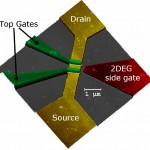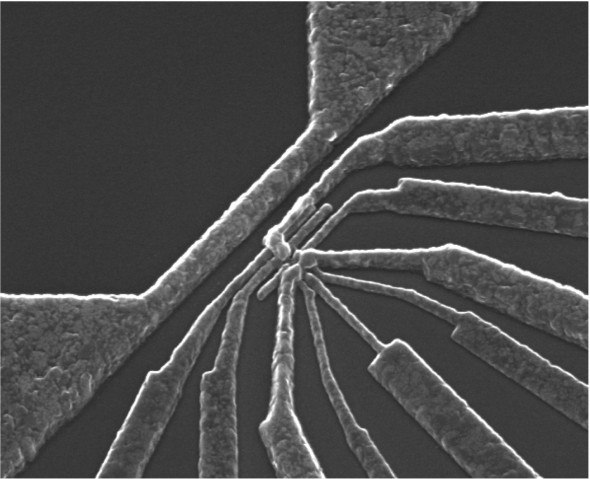
An old quantum dot design fabricated in silicon at the University of Wisconsin-Madison. Courtesy M. Eriksson.
The spin of an electron in silicon may act as an information carrier in future information technologies, from quantum computers to spintronics. For quantum information applications, the spin of cold localized electrons in silicon can make a good quantum memory due to the purifiability of the spin environment (a spin-0 nuclear isotope is available) and silicon’s inherently weak spin-orbit interaction, which isolates information stored in the electron spin from charge movement and noise.
Quantum dots allow for ready tunability and alignment of the confined electron (for physical transport, computation via qubit-qubit coupling, rotation, readout, initialization), the potential for a large scale fabrication route with present-day lithographic techniques, and the benefit of prior proof-of concept work in GaAs coupled quantum dot devices.

Very small quantum dots constructed in Si/SiO2 devices. Courtesy A. Dzurak, University of New South Wales.
Silicon is unique over other quantum dots such as in III-V semiconductors because it has an indirect band-gap. This results in extra states, often referred to as “valley” states, which complicate the physics of silicon qubits and in particular of relaxation of qubit states. Understanding the limitations imposed by these valley states is one of the key problems in silicon-based quantum computing.
Our work has focused on understanding the dominant mechanisms of relaxation of all excited states of confined electrons – orbital, spin, valley – with increasingly realistic considerations for actual devices. We have found, for example, that considering imperfect interfaces has been critical to understanding the behavior of silicon spin qubit relaxation, in sharp contrast to that of GaAs quantum dots.
Spin-valley lifetimes in a silicon quantum dot with tunable valley splitting – arXiv:1302.0983
C. H. Yang, A. Rossi, R. Ruskov, N. S. Lai, F. A. Mohiyaddin, S. Lee, C. Tahan, G. Klimeck, A. Morello, A. S. Dzurak
- Here beautiful experimental results on spin and valley state relaxation in silicon CMOS-style quantum dots from the University of New South Wales are explained by a new theory which takes into account the realistic (that is, rough) interfaces in such devices. A new mechanism for phonon relaxation is proposed due to spin-orbit mixing to excited valley states, previously considered negligible and never considered before, and a phenomenological theory is developed to explain the relaxation data over a wide range of magnetic field for 1, 2, or 3 electron quantum dots. It is expected that this new mechanism we propose is present in all silicon quantum dot qubits.
Download the Nature Communications paper here. And be sure to download the Supplementary Material (ncomms3069) as well, which includes the new theory for spin-valley relaxation in realistic silicon quantum dots.
Relaxation of excited spin, orbital, and valley qubit states in single electron silicon quantum dots – arXiv:1301.0260
Charles Tahan, Robert Joynt
- Here we present old and new calculations on spin qubit relaxation in ideal silicon quantum dots (with a particular emphasis on the SiGe variety), as well as the orbital and valley relaxation due to phonon emission.
- We also estimate spin relaxation due to charge noise and other effects. This review-ish type paper includes a history of the “bulk”-like relaxation mechanisms in silicon and a thorough derivation of the deformation potential Hamiltonian in strained silicon as well as the valley Umklapp relaxation rates for an ideal (smooth interface) dot – which may be very useful to those interested in such things.
- The valley relaxation times for ideal dots show very long possible valley lifetimes, which led us way back when to postulate (in a crude way) on the possibility of valley-based qubits in silicon (see here or here and the QIP paper by Eriksson et al). That possibility is unlikely in realistic dots, where the valley-matrix element is probably usually big (see our theory in the more recent paper with UNSW), which is why in this paper we use the word “ideal” a lot in the valley relaxation section. For isolated donors, on the other hand, we know the valley state lifetimes can be long.
Download the arXiv preprint here.
Older work:
C. Tahan, Thesis August 2005, Silicon in the quantum limit: Quantum computing and decoherence in silicon architectures